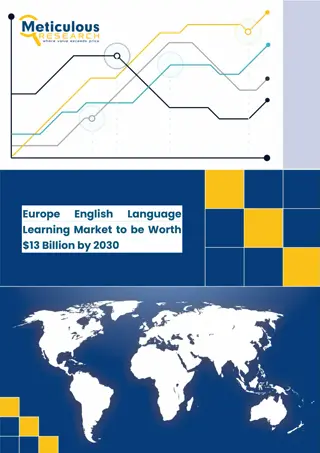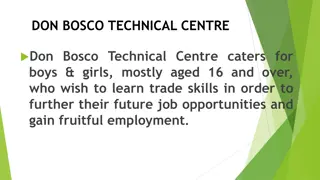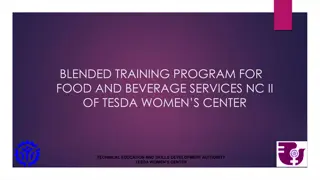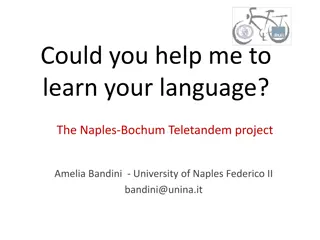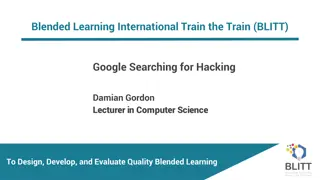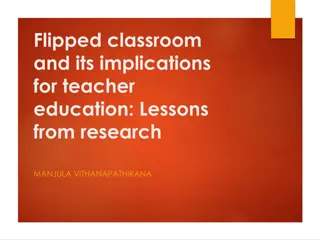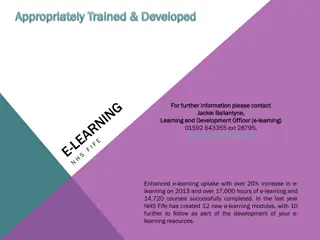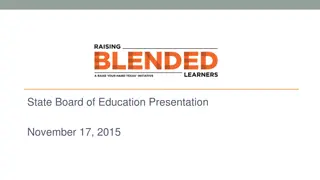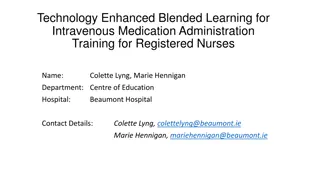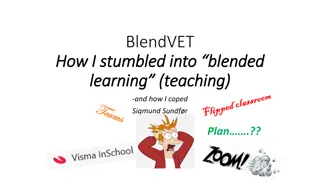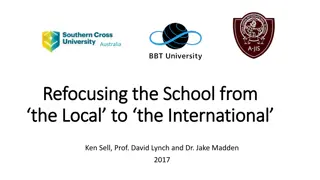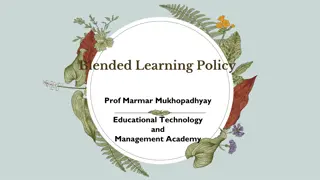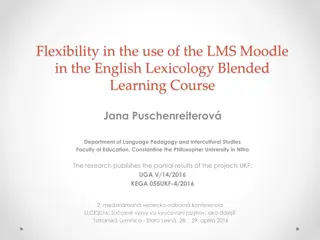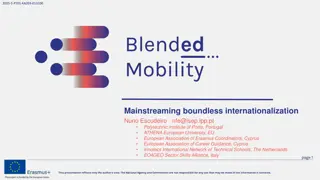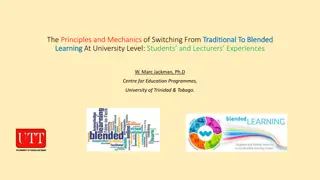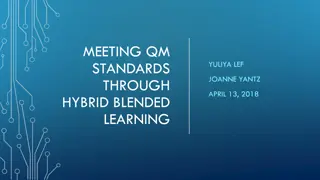Blended Learning Practices in Education
Blended learning combines online and in-person teaching to enhance student learning experiences. This method, when implemented effectively, can improve writing skills, critical thinking, and technological literacy. Various resources and tools are available to support blended learning in educational settings, such as MOOCs, Coursera, and MIT's history projects.
Uploaded on Mar 08, 2025 | 0 Views
Download Presentation

Please find below an Image/Link to download the presentation.
The content on the website is provided AS IS for your information and personal use only. It may not be sold, licensed, or shared on other websites without obtaining consent from the author.If you encounter any issues during the download, it is possible that the publisher has removed the file from their server.
You are allowed to download the files provided on this website for personal or commercial use, subject to the condition that they are used lawfully. All files are the property of their respective owners.
The content on the website is provided AS IS for your information and personal use only. It may not be sold, licensed, or shared on other websites without obtaining consent from the author.
E N D
Presentation Transcript
The term blended learning both online and in-person learning experiences when teaching students. The Glossary of Education Reform - http://edglossary.org/blended-learning/ blended learning is generally applied to the practice of using Book: Blended: Using Disruptive Innovation to Improve Schools, M. Christensen, Michael Horn, and Curtis Johnson - - http://www.amazon.com/Blended Schools/dp/1118955153 Blended: Using Disruptive Innovation to Improve Schools, by http://www.amazon.com/Blended- -Disruptive Schools/dp/1118955153 by Clayton Disruptive- -Innovation Innovation- -Improve Improve- - Video: Blended Learning to Improve with Michael B. Horn: https://www.youtube.com/watch?v=L5EdjW1rTH4 Blended Learning to Improve Schools On Youtube at Google Talks https://www.youtube.com/watch?v=L5EdjW1rTH4 No definite methodology; BL should be used to fit the specific teaching situation; everybody blends differently
(image found at: http://tiie.w3.uvm.edu/blog/ubiquitous- learning/#.VzmF3GZrrUp )
re-examine traditional learning space and pace redesign a course involving digital tools integrate 21st-century technology in teaching BL can improve writing skills and contribute to critical thinking (as long as it is not used to replace traditional ways of learning writing essays or reading books but rather to complement them) students are required to use digital and online technologies -- they naturally acquire more technological literacy and greater confidence using new technologies
MOOCs Coursera - https://www.coursera.org/ Blended Learning at MIT BL for teaching history http://americanyawp.com/ http://historyinthecity.weebly.com/timeline.html http://historyinthecity.weebly.com/narratives prohibition.html BL for teaching history some great projects http://americanyawp.com/ http://historyinthecity.weebly.com/timeline.html http://historyinthecity.weebly.com/narratives- -of prohibition.html some great projects of- -
1) Network visualization https://gephi.org/ 2) Network overview - - https://nodexl.codeplex.com/ 3) Map-making and geospatial information - http://www.qgis.org/en/site/about/features.html 4) Creating websites - http://www.wix.com/ 5) Creating fake Facebook -like pages - http://thewallmachine.com/ 6) Whiteboard-style animation - http://www.videoscribe.co 7) Blogs and media projects- https://wordpress.com/ 8) Organizing research https://www.zotero.org/ 9) Video projects www.youtube.com & https://plus.google.com/ 10) Presentations - https://prezi.com/dashboard/ https://nodexl.codeplex.com/
Technology must be available and working. Universities must invest in the digital education of their teachers. BL must adhere to the same goals and disciplines as other learning programs. BL must include clearly defined outcomes, be effective, relevant, and applicable on the job. Learning must remain the focus of BL. Use BL ONLY if it enhances learning.
Dont we all already use BL in one form or another? How does it contribute to a better understanding of the material? When and where is BL a useful method? What support is available for teachers to use BL in a responsible and adequate way? Could we have more support in terms of using and managing our ICT tools?
My blog posts on BL: https://thoughtfulteaching.org/2016/05/17/blended-learning-and-teaching-humanities- in-a-digital-age/ and https://thoughtfulteaching.org/2016/05/25/moocs-and-blended-learning/ Flipped classroom Flipped classroom Giving a group of students the task to prepare a session and lead the discussion Finding online sources for a topic and evaluating them critically WIKI http://nl.politiekeopera.wikia.com/wiki/Politieke_Opera_wiki WIKIs Opera and Politics in Europe, B.A., first-year students Video projects: Video projects Europe and the Other B.A., second-year students https://www.youtube.com/channel/UClx7TpscGlWYuB6w_LxSYbw Cultures of Nationalism in Europe M.A. students https://www.youtube.com/channel/UCckIvezeFBWp2f5ZDkiAG9g Using digital databases Using digital databases like Empire Online - http://www.empire.amdigital.co.uk/ Using blogs blogs and the discussion board on Blackboard
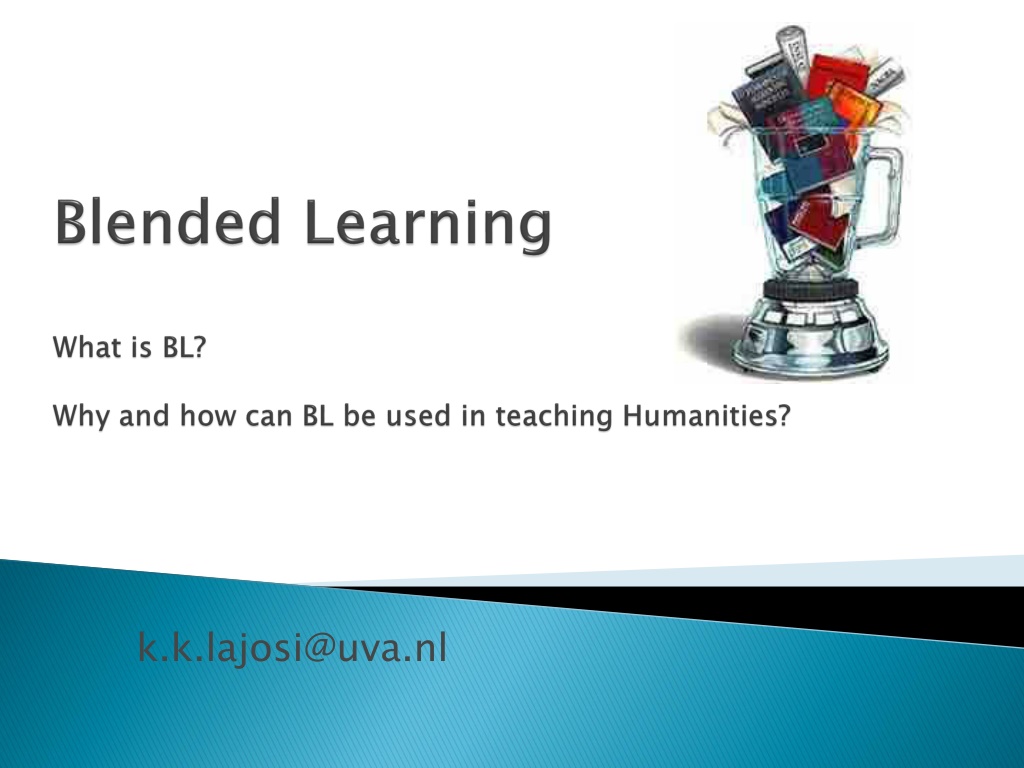
 undefined
undefined






